April 13, 2009
Projects
No Comments
For another project in progress, I needed to test the “off” leakage current of neon bulbs. Along the way I discovered some interesting things. First, let’s take a look at the test subjects.
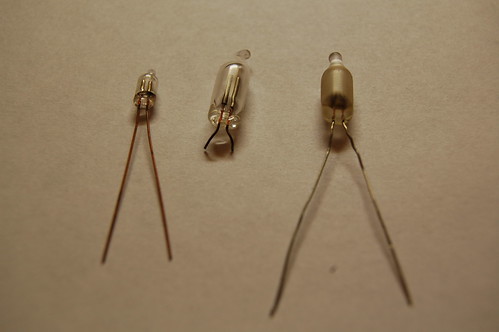
The lamp on the left side is a brand new miniature-type, the middle lamp pretty much represents the average neon lamp, and the lamp on the right is a special “frosted” lamp that I pulled out of some old equipment. Sorry, I do not have type numbers for these lamps, and they are not marked. Some older neon lamps were marked with the type number when the seal was crimped.
The testing used a power supply adjustable from 0V to 40V and a Fluke 87 multimeter. Any good multimeter with a 10MΩ input impedance can be used to measure extremely low currents by wiring the meter in series (like an ammeter) while it is in volts mode. Tests of the tiny neon lamp and the “average” neon lamp used the meter in mV mode, while tests of the frosted lamp used the volts mode. The tests were conducted at room temperature at normal indoor lighting conditions. Before testing, each lamp was washed with 90% isopropyl alcohol and dried with canned air.
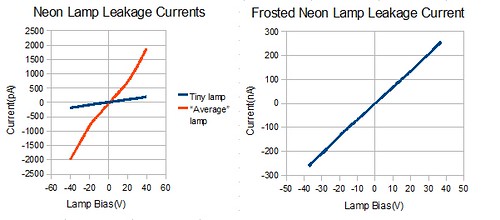
There are some very interesting observations to be made with this data. The tiny lamp exhibits very low leakage current, peaking at 200pA. The “average” neon lamp peaks at 2nA, and the frosted lamp peaks at 263nA. I tried a few more lamps of each type and although they vary quite a bit, each type of lamp approximates the same current as the data above. It is due to the construction of the lamps themselves. According to Techlib.com, the increased leakage current is due to the radioactive thorium present in the lamp electrodes.
If it’s possible for radiation to increase the leakage current, I surmised that a strong light source could increase it as well. Taking another “average” neon lamp, I measured a leakage of 2.8nA at 40V. When exposed to a very bright white LED flashlight, the leakage current increased to 11.0nA, and when exposed to an ultraviolet LED flashlight, the leakage current climbed to 16.6nA. It may be that the photons impinging on the electrodes cause electrons to “leap” from the outer electron shell of the metal atoms and drift (due to the electric field between the two electrodes) across to the opposing electrode. This shows up as the increased drift current.
By increasing the temperature of a neon bulb, I was able to increase the leakage current as well. At the same time, I discovered that some small amount of water vapor still remained as a film on the surface of the bulb. For the case of the tiny neon bulb, the leakage current of 200pA fell to 50pA after a few seconds of applied heat, invalidating my previous experiments. As the temperature of the bulb increased, the leakage current increased to 1100pA before I removed the heat. This principle is the same one that enables vacuum tubes to operate–the heated cathode generates a space charge “cloud” of electrons that drift depending on the applied potential.
For my application, I would rather not have any thorium in the lamp since I want the leakage current to be as low as possible.
April 12, 2009
Cleverness
1 Comment
Recently I purchased a number of nixie tubes from the local electronics flea market:
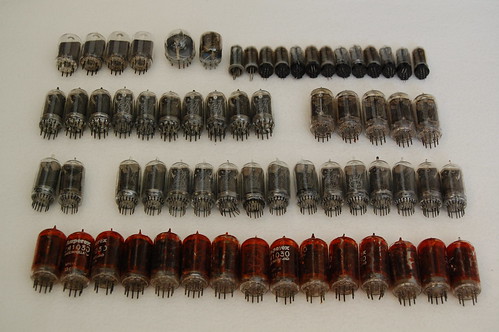
A few of them caught my eye. This Burroughs B-5448 one was most likely used in a calculator or possibly a meter to indicate plus and minus as well as the overload condition.
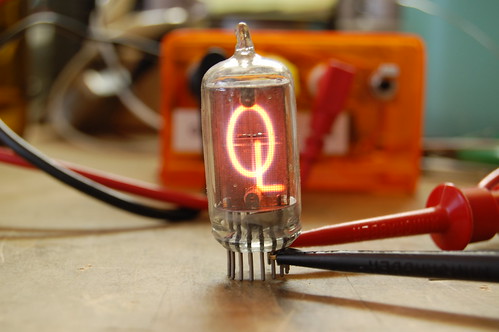
And this National NL-989 was used for indicating the unit or mode of a multimeter. There are two “partitions” in this nixie tube: one contains the symbols “A”, “M”, and “K”, while the other contains “C”, “V”, and “Ω”. The multimeter would have used this to indicate “AC”, “MV”, “KV”, “MΩ”, “KΩ”, and so on.
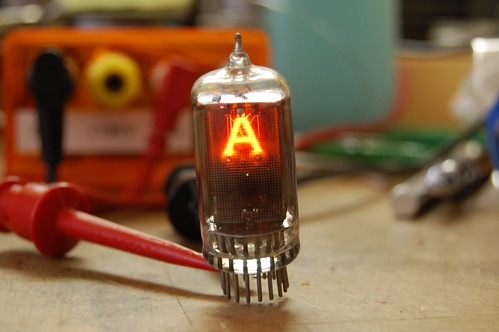
Notice how the glow is a different color in each tube? My camera did an excellent job of reproducing the correct color, so what you see is very close to what the ionized gas actually looks like. The National tube appears to contain mostly neon, while the Burroughs shows light blue “fringing”, indicating the presence of mercury, which was used to increase the lifespan of the tube.
April 12, 2009
Cleverness
No Comments
At the electronics flea market I found a rather interesting-looking vacuum tube. It appears to be a CRT but with a metal cap at the end.
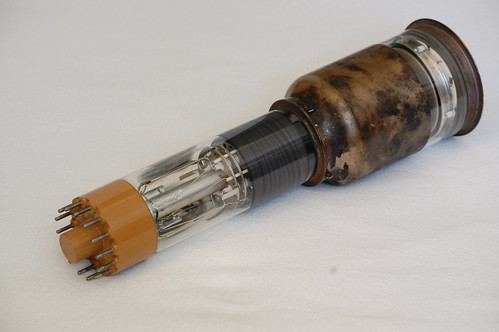
As it turns out, this device is a memory which could have been used in some old computers, storing around 16 kilobits. It could also have been used in radar systems for converting polar coordinate-based sweeps to raster sweeps (like a TV). The socket end contains an ordinary electron gun like the one found in a CRT, but the front end does not contain the usual phosphor screen. Instead, there is a 1mil thick sheet of mica with a fine grid of wires laid on top. On the other side of the mica there is a metal plate.
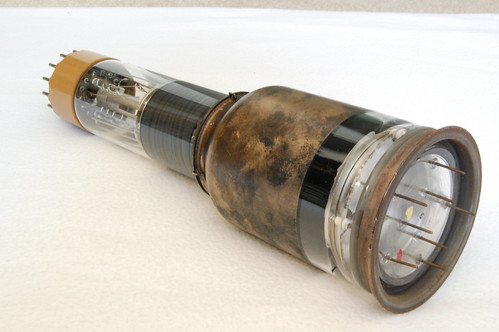
Here’s a closeup showing the metallic screen on the front. The mica underneath capacitively stores electrons that are laid down by the electron beam. This memory can store analog waveforms since higher voltages are represented by a higher density of electrons at a particular spot, and lower voltages correspond with a lower electron density.
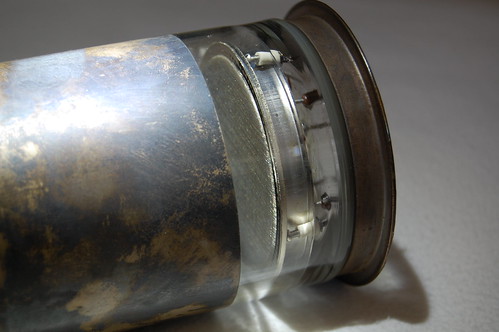
Data for the tube is available from David Forbes.
Here are a couple of other sites with information:
Åke’s Tubedata
World Power Systems
Virtual Valve Museum
Cold War Infrastructure (A full-page RCA ad for the device)
April 5, 2009
Projects
10 Comments
Recently I completed the construction of a Dekatron-based kitchen timer. A Dekatron is an electronic counting device used in the middle of the 20th century for counting pulses or dividing input pulses. You can find a very good introduction to the devices at Mike’s Electric Stuff. My timer is certainly not the first. This gentleman has created a rather military-looking kitchen timer that uses three Dekatrons.
Dekatrons are relatively difficult to find, so I decided to use a single Dekatron in my timer. Actually this project is an old one that I revisited. The original project was just going to be a spinner, but I had trouble with the driving circuit (it never worked reliably). For the 2008 Maker Fair I dusted it off and tried to power it up–with 12V instead of 5V. The power supply and microcontroller did not appreciate it and the whole thing stopped working. The second time around I decided to turn it into something useful. Here it is.

The driving circuit in the Dekatron kitchen timer is based on a circuit drawn up by Mike Moorrees. You can find the circuit at the NEONIXIE-L mailing list files section. There’s a good excuse for you to join. If you’re interested at all in antique display devices (not just Nixie tubes) you need to join.

There are twenty minutes remaining on the timer. You can read the time using the scribed lines on the brass ring around the Dekatron. The ionized gas in the tube glows purple because of the high argon content.
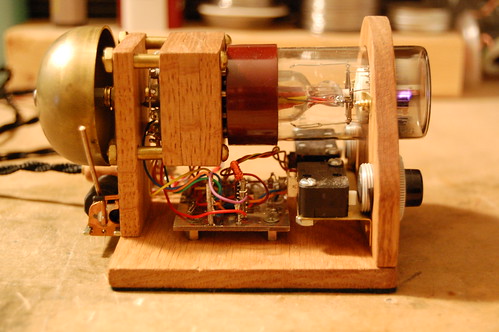
In this side view, you can clearly see the high voltage power supply. It has a copper-wound ferrite toroid. The power supply converts 5V up to 450V by a MAX845 that pulses the transformer at 535KHz, and the 150V output of the transformer gets stepped up to 450V through a 3-stage voltage multiplier.
Time is kept and the clock is controlled by a PIC16F84. The brass bell at the end rings once the timer expires. After ringing the bell, the PIC turns off the high voltage supply and enters sleep mode. Pressing a button wakes up the microcontroller and begins a timing cycle.
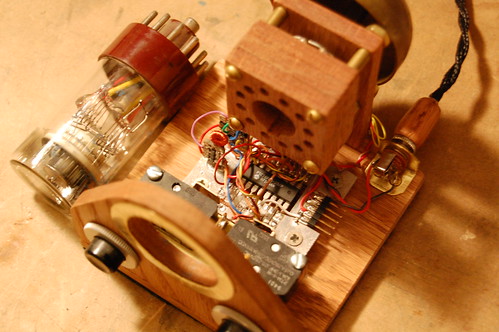
You can see the socket more clearly when the Dekatron is removed. My homebrew drill press for my Dremel tool helped tremendously to drill accurately-placed holes for the pins.
On the right side the power connector provides 5V to the timer from an old cellphone charge adapter. Don’t throw away these adapters! The small ones often contain a very simple off-line isolated power supply that can be modified to produce other output voltages. You can recycle them for projects quite easily. Perhaps I will write an article on this.
The 5-pin connector on the board is used to program the PIC. The PIC16F84 is old enough that it does not support in-circuit debugging. It was Microchip’s very first product on their flash process which has made them so much money over the intervening years.
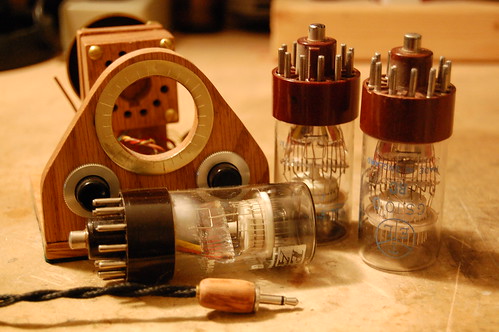
Here is the extent of my Dekatron collection. They are all type GS10D, which is a decimal selector tube with two sets of guide electrodes. The Dekatron in the front of the timer does not work. Can you see why?













